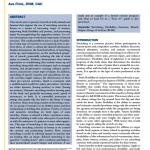 Stretching is sometimes used to compliment a physiotherapy treatment and depending on the individual can be implemented into a treatment/ exercise plan. However, it is important to understand when stretching should and shouldn’t be used, as even though it looks simply and easy, technically its important to understand where and how to hold a stretch, but also if the horse or dog is not capable for stretching is ultimately the question the therapist should be asking themselves. If done incorrectly or the stretch is too advanced for the animal it can be damaging for the soft tissues, along with the time in rehabilitation, if done too early in the rehabilitation program. Stretching should also be carried out AFTER a warm up, to avoid over stretching and damaging muscle fibres, providing an efficient stretch.
Stretching is sometimes used to compliment a physiotherapy treatment and depending on the individual can be implemented into a treatment/ exercise plan. However, it is important to understand when stretching should and shouldn’t be used, as even though it looks simply and easy, technically its important to understand where and how to hold a stretch, but also if the horse or dog is not capable for stretching is ultimately the question the therapist should be asking themselves. If done incorrectly or the stretch is too advanced for the animal it can be damaging for the soft tissues, along with the time in rehabilitation, if done too early in the rehabilitation program. Stretching should also be carried out AFTER a warm up, to avoid over stretching and damaging muscle fibres, providing an efficient stretch.
When muscle fibres lengthen, so do the other components in the fibre, one being the muscle spindle, which triggers the stretch reflex, this tells the muscle to contract which is why initially animals may attempt to pull back the limb. It’s important to not to try and overstretch initially, but to wait for these reflexes to relax and then progress the stretch a little further. If the horse doesn’t relax go to a reduced stretch and ask the owner to repeat, it may be due to the horse being stiff or it being too intense for them at that moment. It may also require further physiotherapy treatments to help the animal become more comfortable, as not every animal is suitable for stretching on the first treatment.
Once they accept the stretch and you can hold an effective stretch the muscle spindle habituates to the new length and decreases signaling. The golgi tendon organ senses a change in the tension and activates a lengthening reaction for the soft tissue, inhibiting muscle contraction and initiating relaxation, protecting muscles, tendons and ligaments.


